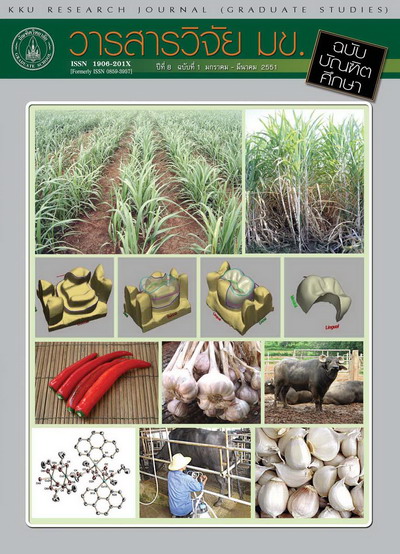Synthesis, X-ray Structures and Spectroscopic Characterization of Five New Polynuclear Paddle-wheel Cu (II) Complexes Containing Carboxylate as a bridging ligand
Keywords:
Copper(II)(คอปเปอร์(II)), Crystal structure(โครงสร้างผลึก), Carboxylato bridge(สะพานคาร์บอกซิเลต)Abstract
The synthesis, spectroscopic and structural characterization of five new polynuclear paddle-wheel copper(II) complexes [Cu4(dpyam)2(OCOC2H5)2(μ-O2CC2H5)6(H2O)2][Cu2(μ-O2CC2H5)4(H2O)2]·(DMF)21, [Cu6(phen)2(H2O)2(µ-O2CC2H5)12]n[Cu2(µ-O2CC2H5)4(H2O)2]2n·(H2O)0.5n2, {[Cu4(phen)2(µ-O2CC2H5)8]·(H2O)}n3 (dpyam = di-2-pyridylamine, phen = 1,10-phenanthroline), [Cu2(μ-O2CC6H4OH)4(C7H7NO)2]·6H2O 4 and [Cu2(μ-O2CCH3)4(C7H7NO)2] 5 are described. All compounds consist of dinuclear unit, in which the two Cu(II) ions are bridged by four syn,syn-η1:η1:μ carboxylates (C2H5CO2-1-3, C6H4OHCO2-4 and CH3CO2-5), showing the paddle-wheel cage type. The Cu(II) chromophores have a square pyramidal geometry. Both terminal position of paddle-wheel unit in 1 is linked with mononuclear Cu(dpyam)(OCOC2H5)(H2O) units by propionate bridges showing syn,anti-η1:η1:μ coordination mode. The 1D structures of compounds 2 and 3 consist of polymer chains of mononuclear Cu(μ-O2CC2H5)2(H2O)(phen) and dinuclear Cu2(phen)2(µ-O2CC2H5)4 repeating units (for 2 and 3, respectively), connecting with Cu2(μ-O2CC2H5)4 paddle-wheel dinuclear units. Within mononuclear and dinuclear units, the Cu(II) ions have a square pyramidal geometry. However, the outer sphere of compounds 1 and 2 consists of the Cu2(μ-O2CC2H5)4(H2O)2 paddle-wheel molecule in which Cu(II) ions involve a square pyramidal geometry. Compounds 4 and 5 are the dinuclear paddle-wheel molecule and they have 4-acetylpyridine ligand occupies the axial position of each Cu(II) ion.
งานวิจัยนี้ได้สังเคราะห์ ศึกษาสมบัติทางสเปกโทรสโกปีและโครงสร้างผลึกของสารเชิงซ้อนพอลินิวเคลียร์คอปเปอร์(II) ที่มีคาร์บอกซิเลตเป็นลิแกนด์สะพานโครงสร้างของสาร [Cu4(dpyam)2(OCOC2H5)2(μ-O2CC2H5)6(H2O)2] [Cu2(μ-O2CC2H5)4(H2O)2]·(DMF)21, [Cu6(phen)2(H2O)2(µ-O2CC2H5)12]n·[Cu2(µ-O2CC2H5)4(H2O)2]2n·(H2O)0.5n2, {[Cu4(phen)2(µ-O2CC2H5)8]·(H2O)}n3, [Cu2(μ-O2CC6H4OH)4(C7H7NO)2]·6H2O 4 และ [Cu2(μ-O2CCH3)4(C7H7NO)2] 5 ประกอบด้วยหน่วยไดนิวเคลียร์ที่มีโครงสร้างแบบpaddle-wheelและมีคาร์บอกซิเลต(C2H5CO2-1-3, C6H4OHCO2-4 และ CH3CO2-5)สี่หมู่เป็นลิแกนด์สะพานแบบsyn,syn-η1:η1:μเชื่อมระหว่างไอออนคอปเปอร์(II)ทั้งสองโดยแต่ละไอออนคอปเปอร์(II)มีโครงสร้างแบบsquare pyramidสำหรับสาร1ที่ปลายทั้งสองข้างของหน่วยไดนิวเคลียร์paddle-wheelนี้จะเชื่อมต่อกับหน่วยมอนอนิวเคลียร์Cu(dpyam)(OCOC2H5)(H2O)ด้วยลิแกนด์สะพานโพรพิโอเนตแบบsyn,anti-η1:η1:μสาร2และ3มีโครงสร้างเป็นสายโซ่ที่มีหน่วยpaddle-wheelเชื่อมต่อกันด้วยสะพานมอนอนิวเคลียร์Cu(phen)(μ-O2CC2H5)2(H2O)สำหรับสาร2และสะพานไดนิวเคลียร์Cu2(phen)2(µ-O2CC2H5)4สำหรับสาร3แต่ละไอออนคอปเปอร์(II)ในหน่วยมอนอนิวเคลียร์และไดนิวเคลียร์มีโครงสร้างแบบsquare pyramidนอกจากนี้นอกเขตโคออร์ดิเนชันของสาร1และ2ยังมีโมเลกุลpaddle-wheel Cu2(μ-O2CC2H5)4(H2O)2ด้วย สาร4และ5มีโครงสร้างเป็นไดนิวเคลียร์paddle-wheel ที่มี3-ไฮดรอกซีเบนโซเอตและอะซิเตตเป็นเป็นลิแกนด์สะพานเชื่อมระหว่างไอออนคอปเปอร์(II)ทั้งสองและมี4-อะซิทิลพิลิดีนเป็นลิแกนด์ในตำแหน่งปลายทั้งสองข้างของแต่ละไอออนคอปเปอร์(II)



